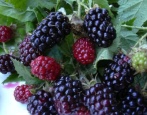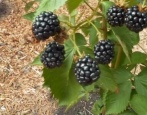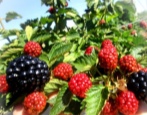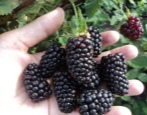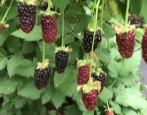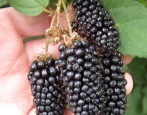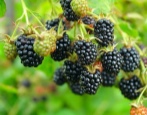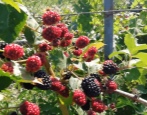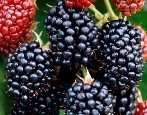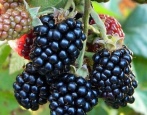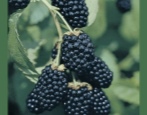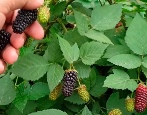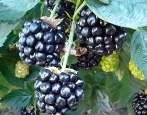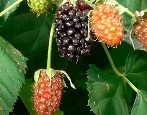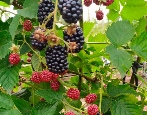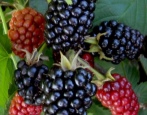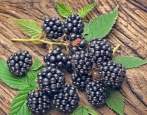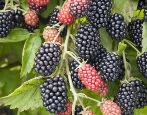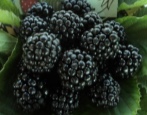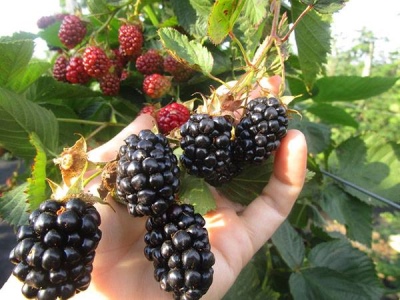
- Authors: USA, John Clark and James Moore
- Taste: sweet
- Scent : strong, blackberry with hints of black currant
- The presence of thorns: Yes
- Repairability: Yes
- Tasting assessment: 5
- Berry weight, g: 6-7
- Berry size: large
- Berry color: black
- Fruiting period: 40-50 days
Blackberries are a vitamin, tasty and fruitful berry - an infrequent guest in the gardens of Russian gardeners. This is due to its weak frost resistance and the need to follow the rules of agricultural technology for the successful cultivation of the culture. But knowing and observing them, you can get harvests in central Russia, for example, by growing the Black Magic variety.
Breeding history of the variety
Garden blackberries are a popular berry crop in the United States, and it is no coincidence that the best varieties were bred by American breeders. Black Magic (Black Magic) is no exception - a remontant hybrid of Arapaho and APF-12 varieties, created at the University of Oregon in 2003 and patented under the number APF-77.
Description of the variety
Fast-growing, erect shoots of the Black Magic variety need regular shaping to create a medium-dense bush. In this form, the plant is decorative and can serve as a decoration for the garden all season. Annual shoots up to 1.5 m long, last year up to 2.5 m, do not lodge. There are few thorns, there are none at all on the fruit branches. The variety bears fruit on last year's shoots and on the growths of the current season.
Black Magic is characterized by:
satisfactory transportability and keeping quality;
renovation;
high productivity;
drought resistance;
high resistance to diseases and adverse climatic conditions;
insufficient frost resistance.
A feature of Black Magic is the ability to pollinate and set fruit in hot, dry weather. Another advantage is self-fertility, in order to obtain a harvest, it is enough to have one variety on the site, without planting blackberries of other varieties to it.
Ripening terms
Early ripening variety. The fruiting period is 40 to 50 days. On the shoots of last year, flowering begins, depending on the region, in late April - early May. On the growths of the current season, blackberries bloom in late June - early July. Ripening occurs at the beginning of summer, the second harvest is harvested in August-September. If the variety is not grown as a remontant variety, the berries ripen towards the end of July.
Yield
Fruiting of the variety begins from the first year of planting and you can expect up to 1 kg of yield per bush. On the shoots of the last year, the yield is higher - up to 4 kg. The maximum yield of the crop comes from 3 years old - 8-9 kg.
Important! The yield of one season will be the same, regardless of the method of cultivation.
Berries and their taste
Large berries - 6-7 g, shiny, black, in the form of an elongated cone or oval. With an excellent dessert taste, in which the ideal balance of acid and sugar content is achieved. Dense pulp, strong aroma with hints of black currant. In a cool place, in paper or cardboard containers, they can be stored for 3 days. Suitable for fresh consumption, fruits can be frozen, dried, kept pure with added sugar. The taste is highly appreciated by experts - 5 points.
Growing features
The cultivar is cultivated as a remontant variety (expediently in the southern regions) and to obtain a harvest on the shoots of the current year.In this case, in the fall, all shoots are cut to the soil level. Shoots that grow the next year will bear fruit.
Blackberry planting scheme:
the interval between bushes in a row is 1-1.5 m;
the distance between the rows is 2.5-3 m.
The installation of trellises along the rows and the regular tying of shoots on them will make it easier to care for the plants. The trellis method facilitates both harvesting and pruning for proper shrub formation. The trellis can be T-shaped or multi-row, 2.5 m high. The shoots of the last year are tied to one side, young branches to the other. Simple supports are installed if the variety is used for one harvest per season. This is done to facilitate harvesting.
Blackberry seedlings are planted in the spring, when warm weather sets in and the earth warms up. Autumn planting is recommended in the southern regions.
Despite the drought tolerance, blackberries are demanding on soil moisture, watering should be regular and abundant, especially after planting and during flowering and crop formation. Autumn water recharge will help the plant to successfully overwinter.
If, before planting, the beds for blackberries were abundantly fertilized, then in early spring you can limit yourself to fertilizing with nitrogen fertilizers, and during flowering - with a complex with trace elements. In the fall, plants need phosphorus-potassium fertilizing or mulching of a site with blackberry manure. Abundant fruiting will be helped by foliar dressing with the addition of chelates to prevent chlorosis.
Attention! Fertilizers for blackberries should be chlorine free.
In the fall, after pruning, the rows with blackberries are covered with a layer of humus for insulation purposes. After the snow melts, the bushes must be opened. In regions with mild winters, the branches of blackberries are removed from the trellises, carefully laid on the ground, secured so that they do not straighten, and covered with 2-3 layers of covering material or spruce branches. This is quite difficult to do, since the powerful straight shoots of blackberries are difficult to bend.
Site selection and soil preparation
A plot for breaking up a blackberry is selected, if possible, a slope of a lowland, a ravine. The place should be sunny and protected from drafts. A sandy area that is overheated by the sun or a place where water stagnates for a long time in spring, autumn or during rains is completely unsuitable for the successful growth of blackberries. There are no special requirements for the composition of the soil: loams and sandy loams with a slightly acidic reaction, well-drained are an excellent option. If the soil is clayey, it is abundantly filled with compost or rotted manure - a bucket per bush. The soil for planting blackberries is prepared in advance, if the seedlings are planted in the spring, then the preparatory work is carried out in the fall. Stages of soil preparation for Black Magic:
digging to a depth of 40 cm with the removal of weed roots;
adding a nutrient layer of manure or mature compost 10-15 cm;
adding organic residues - crushed bark, branches, improving the drainage properties of the soil and enriching it;
mineral fertilizers;
thorough mixing of the soil mixture and leveling with a rake;
abundant watering and mulching to retain moisture and heat;
installation of a trellis.
Pruning
In the temperate climate zone, in the Moscow region, it is difficult to cultivate Black Magic as a remontant crop due to its weak frost resistance. This is only possible in greenhouses. Therefore, before winter, all shoots are cut at the root.
Reproduction
A bushy variety of blackberries reproduces by dividing the bush, cuttings and root suckers. One blackberry bush produces 5 to 10 replacement shoots per season. Their number directly depends on the size of the plant; you can get a larger number of root suckers by damaging the blackberry root with a shovel.
